A walk along the Head of the Meadow bike trail in the first days of spring can be a master class in cold-weather copulation — of the horticultural kind. In the brush it is evident that some plants need little foreplay to warm up to the act, even when temperatures are still downright frigid. Last week I moved in for a closer look when two plants made particularly unabashed shows of their readiness to reproduce.
The early spring blooms of the pussy willow (Salix discolor) and the American hazelnut (Corylus americana) dispense with the pageantry of seduction altogether. They have neither petals to entice foragers nor scents to lure passersby. Instead, they get straight to business, which in the case of these two native shrubs means sticking their organs out to flap in the breeze.
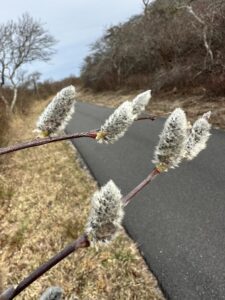
Both the pussy willow and the American hazelnut have male catkins — cylindrical, petal-less structures of unisex flowers. Derived from katteken, an old Dutch word meaning kitten, the term catkin refers to the spikes’ resemblance to a cat’s tail. The nub-like catkins of the pussy willow emerge from their buds in the last days of winter looking like little fur coats buttoned tight to protect the developing flowers from the cold.
Their flowers, though, grow up fast: in sudden pops of yellow, the pollen-covered anthers have already begun to spring out and expose themselves to the elements, letting their fur coats drop to the floor.
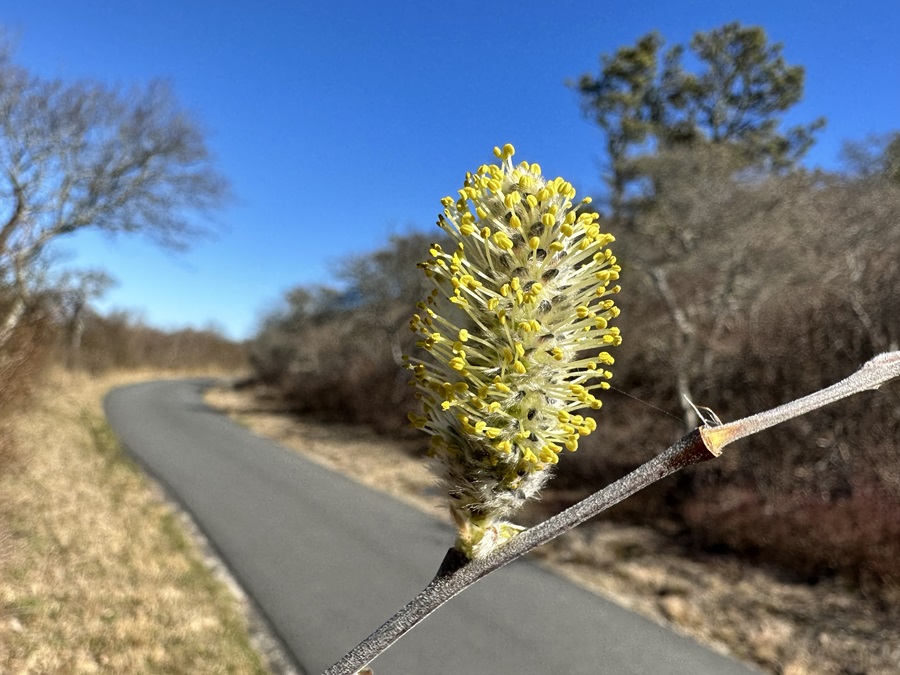
Pussy willow is a sexed species. That means that the help of early-season pollinators like bumblebee queens are needed to transport pollen from a male plant to a female one, where smaller catkins, also devoid of petals, bear scores of erect ovaries ready for action.
Blooming so early in the season, the pussy willow sees no need to advertise with flashy petals or a catchy scent. If any bugs are awake and hungry, Salix discolor is just about the only diner open. In addition to offering pollen, both the male and female catkins serve up helpings of nectar that is tucked deep between the flowers.
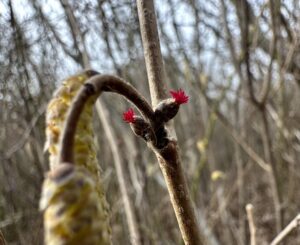
The male and female flowers of the American hazelnut, unlike those of the pussy willow, can be found on the same plant. They are self-incompatible, however, so the pollen still needs reliable transport to another hazelnut bush. Not willing to bet that pollinating insects will be out of dormancy in time to help, Corylus americana instead banks on the wind to move its pollen. Its stripped-down approach to reproduction make sense: petals would be an obstruction, and a scent would be a waste of energy.
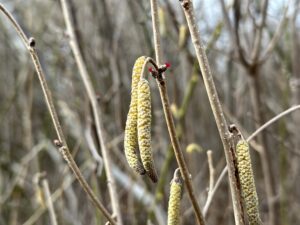
The female hazelnut flowers seen along the bike path begin to bloom at the end of winter, making their first appearances as single red dots atop their scaled buds. They will slowly push out their styles to the “spider stage,” when they look as if they’re reaching out with tiny legs. The rest of the flower’s structure stays hidden in the bud.
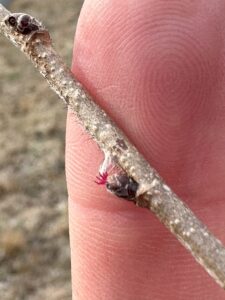
Meanwhile, the male catkins have begun to stir. They were first formed last summer but remained small and underdeveloped through the fall and winter. Sensing that it’s mating season, they have begun to elongate and swell and will soon reach peak maturity when their pollen gets exposed to the wind. At this point, these hairless catkins are a touch more phallic than feline; they look less like waving cat tails than they do like hanging sausages.
The red styles will now wait patiently for a cold gust to bring a shower of pollen. After an afternoon observing so many sex organs up close, a cold shower might indeed be in order.
